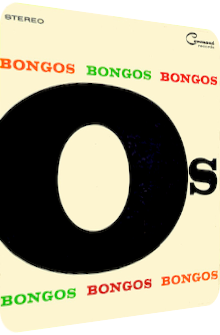
Los Admiradores
Bongos
1959
Exotica was the latest trend at the end of the 50’s, as every fan knows by heart, but there was a subtrend that collectively enthralled an even bigger audience, for its driving factor could be used in all genres: bongos. It needs the appearance of a centipede to allot each limb to a specific release. The bongo craze was indeed huge, and as with every trend, the aftertaste is usually bitter: as the competition grows, so does the amount of arbitarily gathered session musicians and “quick buck” releases. Enter Los Admiradores, a Jazz supergroup comprising of great talent and well-known names. They have come up with two releases in their career, for as is the case with all artificially gathered supergroups, they do not last forever and quickly move on.
Their 12-track album is simply called Bongos and is released in 1959 on audiophile Enoch Light‘s own label Command Records. Among the players are guitarist Tony Mottola, multi-instrumentalist Stanley Webb, mallet instrumentalist Artie Marotti, pianist Moe Wechsler as well as the bongo players Don Lamond and Willie Rodriguez among many brass players, percussionists and woodwind experts. So is Bongos just another one of those, well, bongo records? No, not at all, for the bongos are surprisingly enough never in the limelight, at least not exclusively so. Since it is comparatively easy to come up with eclectic bongo solos, one might imagine them to be all over this LP. Except that they are not. The use of bongos never feels gimmicky, there is a full band behind the record, not just a bunch of bongo players trying to come up with sophisticated battles and hypercomplex segues. The presented material from the Golden Book of Jazz Standards is mercilessly exotified and is more akin to a real Exotica record than many an LP that presents a paradisiac front artwork! So let’s see what Los Admiradores’ debut has in store.
The album starts in a mightily exotic way as Los Admiradores transmute Jack Lawrence’s and Walter Gross’ Tenderly into a midday mirage taking place in a lush oasis surrounded by desert sands. Stanley Webb’s flute introduces the listener to the scenery, Willie Rodriguez’s bongos are firmly in place all the while Artie Marotti’s glockenspiel adds luminescent dew drops to the seething scenery. Once Tony Mottola’s liquedous guitar and Moe Wechsler’s gorgeously gentle piano accompaniment are in place, everything shimmers, making this a superb kick-off of an album whose exotic spirit is otherwise slightly diminished by the all too spartan title and artwork. George Gershwin’s Bidin’ My Time meanwhile sees the band revving up the tempo with shedloads of brass instruments, xylophone blotches and a big band/vaudeville dichotomy of Mexican grandeur. The bongos are unsurprisingly the agglutinating thread to the saltatory arrangement.
While Huddie Ledbetter’s and Paul Campbell’s Sylvie turns out to be a superb midtempo reverie that is carried by a dialogue between Webb’s clarinet and Wechsler’s piano in-between cautiously muffled bongo bubbles, Gerald Marks’ and Seymour Simons’ All Of Me showcases the moist glissando of Mottola’s guitars amid an enchantingly hammock-friendly carefreeness; this jungular afternoon is as much improved by the bongos as it is proud of its aural depiction of doldrums. The traditional Greensleeves then most certainly experiences the biggest transformation from its glacially Gaelic origin and threnodic complexion to a more melancholic and withdrawn but unapologetically tropical hue. The bongos drop along to the flute/guitar mélange, but despite the world-famous melody being firmly in place, the textures somehow transfigure the melancholy and make it much more bearable in this verdured state. Side A is rounded off by Harold Arlen’s long-winded Between The Devil & The Deep Blue Sea, a decidedly jazzy shanty of seemingly improvised tone bursts and free-form guitar prowess as delivered by Tony Mottola. The adjacent brass shards add a more concrete feeling to the wave-like appearance. Watch out for the short bongo outro near the end.
The exoticism is maintained and nurtured on side B as well, there is no stylistic break or gap whatsoever. In fact, a fleeting visit to fantasia is realized right in the very first moments thanks to Lorenz Hart’s and Richard Rodgers’ Blue Moon whose aura of delight and romance is cleverly balanced; Los Admiradores never succumb to chintzy tone sequences and let Bob Haggart’s double bass move and spiral slowly through the bongo bosk illumined by Tony Mottola’s crunchy sun-dried guitar coils. Not entirely nocturnal, the arrangement vaporizes tropical reminiscences with twilight glee. Alex North’s and Hy Zaret’s Unchained Melody evokes the spirit of Arthur Lyman’s Hawaiian Sunset (1959) by augmenting the hazy transcendence of Artie Marotti’s Polynesian vibraphone. The cavernous or mangrove-like arrangement has to be heard to be believed. This is, at least to me, the standout track of the whole album, sleazily mellow, but ever-growing. Stanley Webb’s bass clarinet is the all-important ingredient that floats freely through this mildly Caribbean epithelium. Even the bongos are outshone for a moment.
Don’t Blame Me by Dorothy Fields and Jimmy McHugh follows and returns to the more upbeat, lively tropes of Jazz. Frilly and tumular thanks to the ubiquitous bongo allure, Tony Mottola’s slick guitar chords meet wonderfully sunset-colored brass blotches, helicoidal piano segues and softened flute airflows whose mild aura is only another adjuvant in a long line of exotic ingredients. The second traditional song of the album follows and is equally altered into another state: the splendid Londonderry Air is a – probably all too pristine – vibraphone-accentuated woodwind realization and coincidentally the only instance where the bongos are a tad too gimmicky and self-sustaining, destroying a lot of the dreamy mood via their constant overlay of otherwise silent microstops.
With Ray Noble’s The Very Thought Of You, however, Los Admiradores return to form: here, the sophisticated bongo textures and stereo-panned plasticity works better as this tune is more of a city prowler than a shangri la-infested piece of tropicana. The brass layers resemble the traditions of Crime Jazz, with the midtempo being tame enough to not cause a tachycardia. The final composition comes from the feather of Arthur Schwartz and Howard Dietz and is called You And The Night And The Music. This is a mercurial big band critter with bumblebee-like brass flaps, steamer foils, xylophone vesicles and cool piano addendums. Even the volume of the timpani is boosted, resulting in a full-force grand finale that exchanges Exotica for town hall vivacity.
Albums about bongos are abundantly available, it is a sumptuous cesspool filled with hundreds of artifacts from the 50’s alone. In hindsight, Enoch Light’s Los Admiradores can take a stand with their flimsically titled Bongos. In fact, it is one of the strongest releases to ever come out on Command Records! This band is loaded with allstars, but this does not mean anything if their power is not used in the right ways. Admittedly, there are moments where a streamlined trade wind shimmers through the leaves of this forest called an album, for instance Tony Mottola’s rather tame work on the guitar. He is capable of so much more, but Exotica, as we all know, is usually more about the amalgamation of textures and less about the prestidigitation and wild imagination of its principal players. This train of thought leads to the bongos themselves, as it is these devices that are clearly advertised here.
Instead of labyrinthine savageries à la Sabu and Chaino, the drums are well-groomed and behave in a distinguished manner. Their clangs and bangs always serve the mood of the respective tune: Sylvie is a soothing piece of high noon tropicana, while the melting pot You And The Night And The Music demands quite a bit more of the drummers who need to depict some enchanted evening with hundreds of people. In the end, it all comes down to this: even if the listener is fully aware of the audiophile nature of LP’s as released on Command Records, this one is first and foremost about the quality of the arrangements, not the recording technique per se, even though the latter is unusrprisingly mentioned time and again. This is one of, as I tend to say, Exotica’s lost records: it is easily available at fair prices on vinyl via eBay, GEMM and other places, but does not trigger the Exotica fan’s synapses due to its bog-standard title and less than vivid front artwork. But this one breathes and lives Exotica – highly recommended!
Exotica Review 353: Los Admiradores – Bongos (1959). Originally published on Jun. 28, 2014 at AmbientExotica.com.
